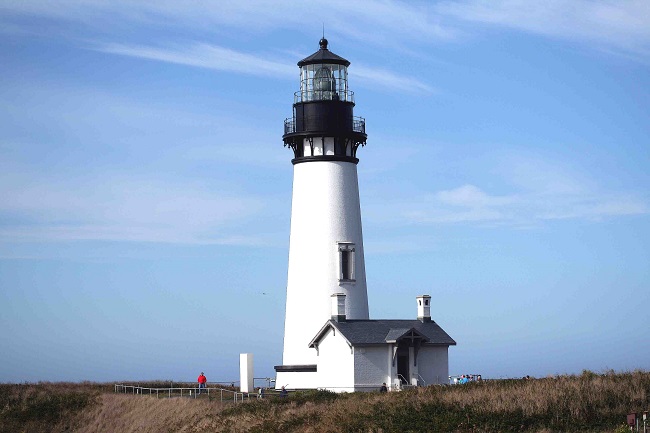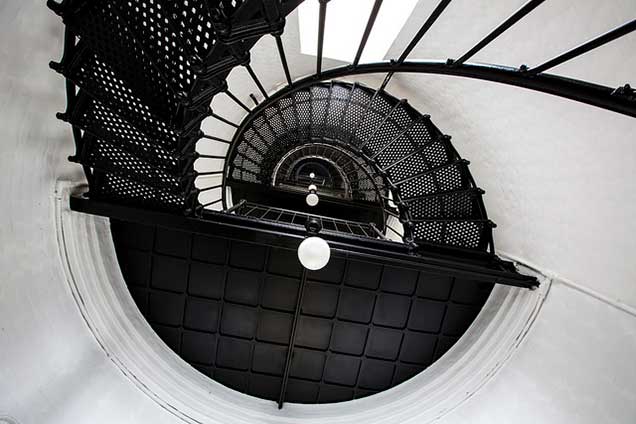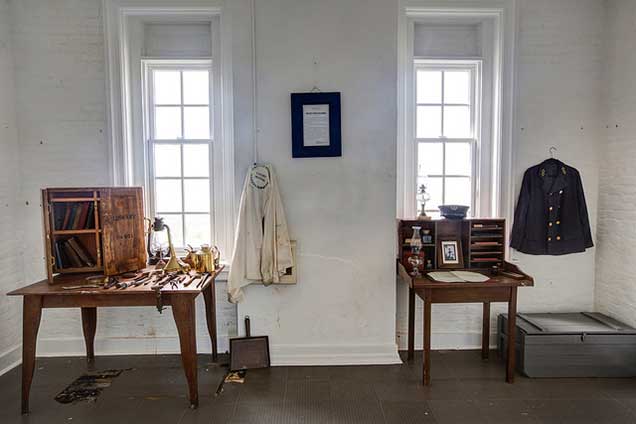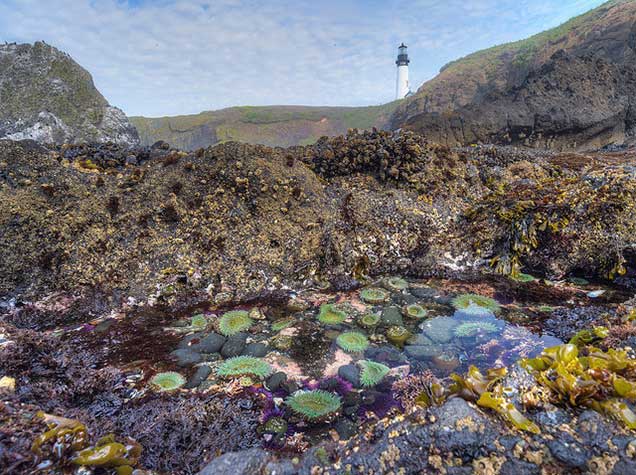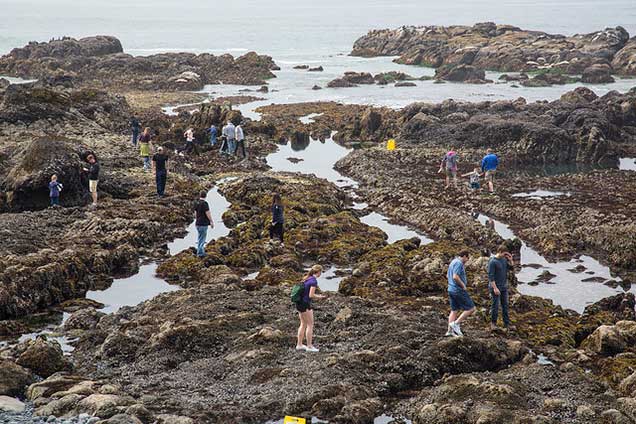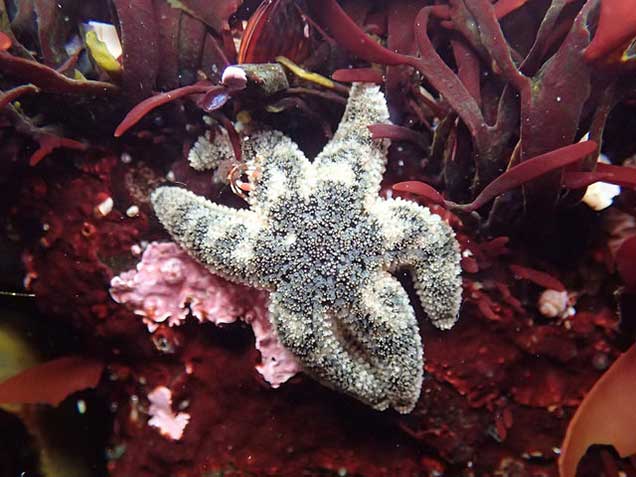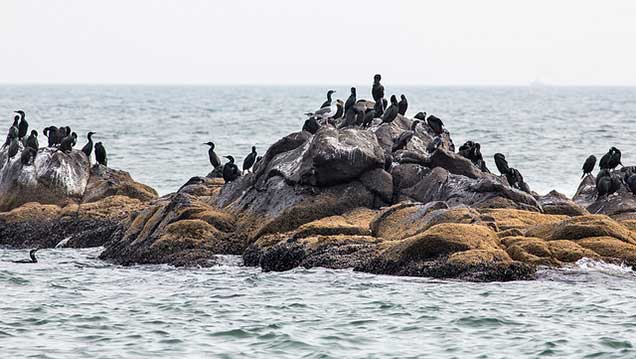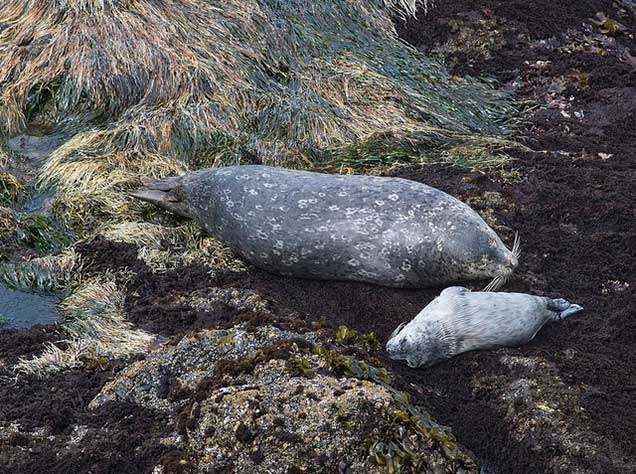
Explore Yaquina Head
From exploring tidepools teeming with life to witnessing Oregon's tallest lighthouse, there is something for every visitor at Yaquina Head.
- Observe Seals
-
Harbor seals can often be seen laying on the near-shore rocks off Cobble Beach and Quarry Cove. The best time to observe them is when the tide is out - use the "tidepool discovery times" for best chances for viewing.
Publication
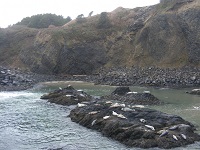
Harbor seals hauled out at Quarry Cove 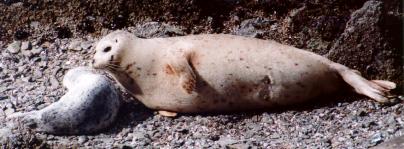
A zoom lens or spotting scope allows a closer look at a seal pup and its mother. In summer months, rangers often set up spotting scopes near wildlife (photo courtesy of Mitch Rohse). - Whale Watching
-

Gray Whale Mural in
the Visitor CenterWhich way are they migrating? If you visit between December and February, they are going south to the calving and breeding grounds in Baja. If you are visiting during March through May they are headed north to their feeding grounds in the Bering Sea.
What about summer (seasonal) whales? Approximately 150 whales spend their time feeding along the Oregon coast during the summer. They are usually medium size whales or cows with calves. Gray whales can grow between 40 to 45 feet long.
How do you look for whales?
- Scan the ocean towards the horizon.
- Look for the blow (spout) that resembles a plume of smoke.
- Once you locate the whale, use your binoculars for a closer look.
- Early morning or evening, when the surf is calmer typically produces the best results.
- Patience makes a good whale watcher!
Publication
- Tidepooling
-
Please remember Yaquina Head is a protected and fragile natural area. The cobbles roll and sea life is very slippery. Tread lightly and take only pictures.
To make your tidepool experience safe and worthwhile:
- Go slowly; keep an eye on the surf and keep small children within arm's reach.
- Walk on bare, dry rocks, avoid stepping on tidepool plants and animals.
- Stay out of the water.
- To avoid injuries to the animals, please OBSERVE them; DO NOT pick them up, poke them, or move them.
Commonly seen animals include anemones, urchins, mussels, barnacles, seastars, and many more.
- Birding
-
Birds are one of the most abundant, easily watched forms of wildlife at the Yaquina Headland. The availability and diversity of habitat at Yaquina attracts different bird species all year-round.
Spring
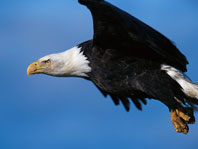
Bald Eagle Spring brings 65,000 common murres, Brandt's cormorants, pelagic cormorants, pigeon guillemots, western gulls, and glaucous-winged gulls to Yaquina's bluffs and offshore rocks. For bald eagles and peregrine falcons, the sea bird nesting season provides an all-you-can-eat buffet! Early in the morning, eagles and falcons can often be seen watching and preying upon seabirds near the Lighthouse.
Barn swallows arrive in the spring to build nests of mud pellets and straw, lined with feathers, on the ledges of the Interpretive Center. Violet-green swallows and peregrine falcons nest on the cliff walls surrounding the Interpretive Center. Watch for them from the parking lot as they dart and dive through the air.
Summer
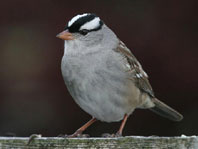
White Crown
SparrowBarn swallows, and violet-green swallows are at Yaquina Head throughout July. Chicks can be seen peeking out of their nests while awaiting their parents' return with food. Large numbers of brown pelicans fly in long lines, low to the water. Pelicans often plunge dive from the air into the water to feed on fish.
Turkey vultures are often seen. The vultures are sometimes confused with bald eagles when in flight. Although both have large wing spans, vultures have a "V" shaped wing angle, while eagles soar with wings nearly flat.
Listen for the distinctive, raspy call of the Caspian tern as it flies over Cobble Beach.
White crowned sparrows and song sparrows can be spotted in the brush along trails and even around the Interpretive Center.
Fall
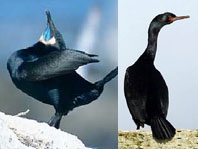
Cormorants 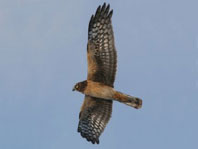
Harriers From late summer through early winter, large numbers of brown pelicans can be seen on off-shore rocks after most the sea birds have left.
Northern harriers have been spotted on the trail between Quarry Cove and the Interpretive Center.
Red-tailed hawks arrive in late summer and early fall. They soar and hover with wings outstretched above Salal Hill.
Brandt's cormorants and pelagic cormorants may remain at their nesting sites through October. In the fall, adult-sized chicks appear dark brown rather than black like the adults.
Winter
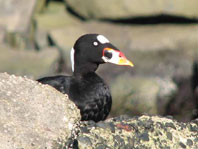
Scoter Look for peregrine falcons on the cliffs above near the Interpretive Center or near the Lighthouse on Colony Rock.
Red-tailed hawks can be seen hovering above Salal Hill.
American kestrels can be seen at Quarry Cove or perching on road signs throughout the area.
Shorebirds, such as surfbirds and black turnstones, feed on barnacles and snails on the offshore rocks.
Western meadowlarks have been spotted in the grass between Quarry Cove and Ocean Bluff.
Black scoters, white-winged scoters, and western grebes can be seen off shore. Surf scoters are visible near Colony Rock, on the north side of the headland, and in Quarry Cove.
- Lighthouse
-
 The historic Yaquina Head Lighthouse (1872) is Oregon's tallest, but just one in a string of lighthouses strategically planned along the Pacific Coast to allow mariners to sail the rocky coastline after dark. The lighthouse is visible when ever the park is open (fog depending).
The historic Yaquina Head Lighthouse (1872) is Oregon's tallest, but just one in a string of lighthouses strategically planned along the Pacific Coast to allow mariners to sail the rocky coastline after dark. The lighthouse is visible when ever the park is open (fog depending).The nightly vigil of watching the light is gone as are the resident keepers and their quarters, but the staff of Yaquina Head guides visitors through the lighthouse with tales of yesteryear. Lighthouse Tour Information: https://www.blm.gov/sites/blm.gov/files/yaquina_head_tourinfo.pdf
Construction History
At the time the Yaquina Head Lighthouse (originally called the Cape Foulweather Light at Yaquina Point) was built, the area was a wilderness. There was no real road to the lighthouse—just a trail that a horse and wagon could traverse partly by traveling along the beach. Construction materials and supplies had to come by way of sea. The Lighthouse Tender Shubrick, a side-wheel steamer, delivered goods to the small cove just south of the headland, where workers hauled them up the bluff.
Construction of the massive white conical shaped tower began in late 1871; with the wall at the base over five feet thick, it was built to last for generations. Once construction was completed, the fixed white light was illuminated on the night of August 20, 1873, when Keeper Fayette Crosby lit the 4-wick lamp fueled by lard oil.
It was equipped then, as it is today with a first order Fresnel lens. The lens was manufactured in Paris in 1868 by Barbier & Fenestre, and shipped from France to Panama, transported across the isthmus, then shipped north to Oregon.
Along with the construction of the lighthouse, a large dwelling for two keepers and their families was built east of the tower. Other structures included a smaller keeper's dwelling, stable, cisterns, and a workshop. Keepers and their families planted and tended a kitchen garden.
Recent History
The 1930s brought many changes to the light station. The light's power source was changed from oil to electricity. A 1000-watt theatrical lamp generating over 130,000 candlepower was installed. The US Lighthouse Service was transferred to the U.S. Coast Guard in 1939. This same year, the light character of Yaquina Head was changed from a fixed to a flashing pattern called a "signature," unique to each lighthouse. Yaquina Head's signature is two seconds on, two seconds off, two on, fourteen off, and then repeats.
Through the years new structures replaced the old. But, as one retired lighthouse keeper put it, "the buildings left a lot to be desired, as winds would come whistling through the buildings with enough force to lift a catalog off the floor." Eighty mile per hour winds are not uncommon at the headland, especially during the wet winter months.
In 1966, the era of the lighthouse keeper at Yaquina Head ended. A computer was installed at Yaquina Head Lighthouse. When the light malfunctioned, the modem automatically notified the Coast Guard's Aids to Navigation Team. A resident keeper was no longer needed on the grounds. The unoccupied quarters eventually fell into disrepair and were removed in 1984.
Children in the Lighthouse
When the lighthouse was constructed in 1872 children of lighthouse keepers and lighthouse visitors were not permitted to climb the 114 stairs in the tower. The US Lighthouse Service feared for their safety. Because Yaquina Head Lighthouse retains its historic stairs, handrails, and balusters, stumbling or slipping between the wide gap in the balusters still poses dangers. For their safety children must be at least 42 inches tall to ascend the lighthouse tower stairs. Additionally, those children over 42 inches tall wishing to climb, must be accompanied by an adult, who may not carry or pick up the child.

